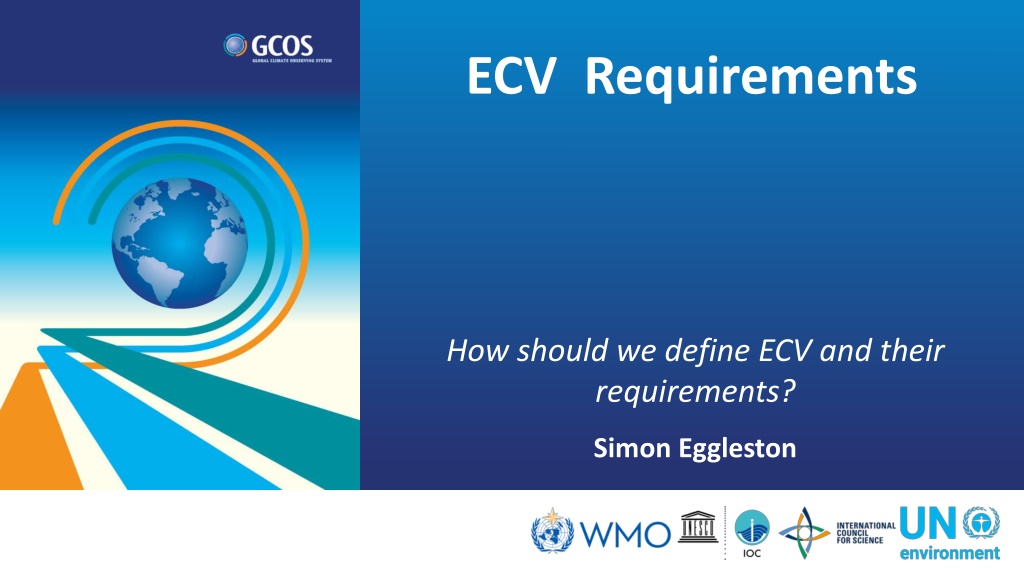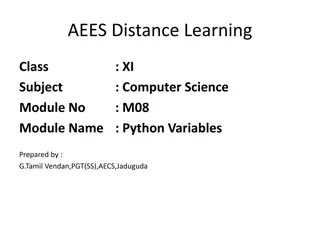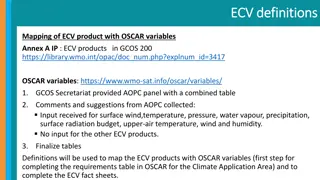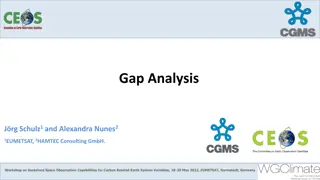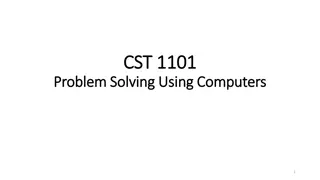Understanding Essential Climate Variables (ECV) and Their Requirements
Essential Climate Variables (ECVs) are physical, chemical, or biological variables crucial for characterizing Earth's climate. They provide empirical evidence for climate understanding, prediction, risk assessment, and more. ECVs must be relevant, feasible, and cost-effective, not as stand-alone variables but as part of a broader concept. Various ECV examples include ocean acidification, surface temperature, carbon dioxide levels, and more. Additionally, climate cycle targets aim to close the carbon budget, manage the global water cycle, and explain biosphere changes effectively.
Download Presentation

Please find below an Image/Link to download the presentation.
The content on the website is provided AS IS for your information and personal use only. It may not be sold, licensed, or shared on other websites without obtaining consent from the author. Download presentation by click this link. If you encounter any issues during the download, it is possible that the publisher has removed the file from their server.
E N D
Presentation Transcript
ECV Requirements How should we define ECV and their requirements? Simon Eggleston
Essential Climate Variables (ECV) Essential Climate Variables (ECV) are physical, chemical or biological variable or group of linked variables that critically contributes to the characterization of Earth s climate. provide the empirical evidence needed to understand and predict the evolution of climate, to guide mitigation and adaptation measures, to assess risks enable attribution of climatic events to underlying causes, and to underpin climate services. must not be understood as a select group of stand-alone variables; they are part of a wider concept
ECV are: ECV are: Relevant: The variable is critical for characterizing the climate system and its changes; Feasible: Observing or deriving the variable on a global scale is technically feasible, using proven, scientifically understood methods; Cost-effective: Generating and archiving data on the variable is affordable, mainly relying on coordinated observing systems using proven technology, taking advantage where possible of historical datasets. Schematic of the ECV concept (Source: Bojinski, et al, BAMS, 2014).
Ocean Acidification Precipitation, Cloud Properties, Water Vapour Surface Temperature Deforestation Mitigation Ecosystem Loss Carbon Dioxide, Methane Sea Level Rise Fisheries Water Carbon Soil Moisture, River Discharge, Lakes, Groundwater, Cryosphere, Water use Sea Surface & Subsurface Salinity, Sea Level, Sea Surface Temperature Soil Carbon, Above-ground Biomass, Fire, GHG Fluxes Inorganic Carbon Radiation Budgets, Temperature Wind speed & direction Coral Bleaching Agriculture Human Health Floods Droughts Water Resources Storms Systemic Risks Security Slow Economic Development Energy Albedo, Latent and Sensible Heat fluxes, Land Surface Temperature Ocean Surface Heat Flux, Sea Surface & Subsurface Temperature, Temperature Heat waves Global Climate Cycles
Climate Cycle Targets Climate Cycle Targets Closing the carbon budget Closing the global water cycle Targets Targets Quantify fluxes of carbon-related greenhouse gases to +/- 10% on annual timescales Quantify changes in carbon stocks to +/- 10% on decadal timescales in the ocean and on land, and to +/- 2.5 % in the atmosphere on annual timescales Close water cycle globally within 5% on annual timescales Explain changing conditions of the biosphere Targets Measured ECVs that are accurate enough to explain changes of the biosphere (for example, species composition, biodiversity, etc.) Closing the global energy balance Targets Balance energy budget to within 0.1 Wm-2 on annual timescales
Essential Climate Variables (ECVs) 2016 Physics Surface Hydrology Air temperature, Wind speed and direction, Water vapour, Pressure, Precipitation, Surface radiation budget. Upper-air Temperature, Wind speed and direction, Water vapour, Cloud properties, Earth radiation budget, Lightning Subsurface temperature, subsurface salinity, Subsurface currents, Ocean surface stress, ocean-surface heat flux, sea- surface temperature, surface currents, sea-surface salinity, sea level, sea state, sea ice River discharge, groundwater, soil moisture, lakes Cryosphere Snow, glaciers, ice sheets and ice shelves, Permafrost Biosphere: Atmospheric Terrestrial Albedo, land cover, fraction of absorbed photosynthetically active radiation, leaf area index, above-ground biomass, fire, land-surface temperature, soil carbon Human use of natural resources: Water use, Anthropogenic Greenhouse Gas fluxes Oceanic Biogeochemistry Inorganic carbon, oxygen, nutrients, transient tracers, nitrous oxide (N2O), ocean colour Biology/ecosystems Plankton, marine habitat properties Composition Carbon Dioxide (CO2), Methane (CH4), Other long-lived greenhouse gases (GHGs), Ozone, Aerosol, Precursors for aerosol and ozone.
ECV Products dischargeRiver discharge Cross-section Are these all needed by users? Are some only used to derive river discharge? River Water Level Flow velocity GCOS Implementation Plan (GCOS-200, annex A) gives requirements for each ECV In general there are more than one item to be observed for each ECV They were called products These are not always well defined Are there any missing ECV needed to characterise the global climate cycles? Lake water level Water extent Are these all well defined? How do ice thickness and ice cover differ? Lake surface-water temperature Lake-ice thickness Lakes Lake-ice cover Lake colour (Lake water- leaving reflectance) Surface soil moisture Soil moisture Are these all well defined? What is surface inundation? Root zone? Freeze/thaw Surface inundation Root-zone soil moisture
Required measurement uncertainty 10 % (relative) 10 cm 10 % (relative) 10 % (relative) 3 cm for large lakes, 10 cm for the remainder 10 % (relative) 5% (for 70 largest lakes) ECV Products Frequency Resolution Stability dischargeRiver discharge Cross-section Daily Daily Few times per year Few times per year Per river 100 m Per river Per river River Water Level Flow velocity 1 cm/yr Lake water level Daily 100 m 1 cm/decade Water extent Daily 20 m 5%/decade Lake surface-water temperature Lake-ice thickness Lakes Weekly 300 m 1 K 0.1 K/decade Monthly 100m 1 2 cm Lake-ice cover Daily 300 m 10 % 1 % /decade Lake colour (Lake water- leaving reflectance) Weekly 300 m 30 % 1 %/decade 0.04 m3/m3 0.01 m3/m3/year Surface soil moisture Daily 1 25 km Soil moisture Freeze/thaw Surface inundation Daily Daily 1 25 km 1 25 km 90 % 90 % TBD TBD 0.04 m3/m3 0.01 m3/m3/year Root-zone soil moisture Daily 1 25 km
ECV Product Requirements GCOS User Needs, assessed by science panels for feasibility and cost. Processing observations into ECV Products Feedback Observations Data provided to users
Information Exchange: Climate Observations to Policy and Action
Defining requirements in the future Defining requirements in the future Requirements for Climate Monitoring The goal, the level to be aimed at where further improvements lead to little or no additional benefits. This would be sufficient for all climate applications OSCAR has a third, intermediate level but the usefulness of this is unclear in climate monitoring where capabilities are changing and users needs being refined Retain information on specific applications The threshold: the minimum needed to produce useful climate information. This would be sufficient for some applications but not all.
Some Questions Some Questions Should the ECV what a user needs or what satisfies scientific curiosity? Are the requirements what is measured now ar aspirational what we think should be measured? Is the ECV what is actually observed OR the parameter that is needed? Satellites generally measure optical or microwave radiation Is the ECV requirement what the user needs or what needs to be observed to achieve that requirement? A user may need gridded precipitation. Should the ECV be accuracy per grid cell, or accuracy per rain gauge? Should the resolution be the grid size needed by the user OR the spatial separation of the stations? A user may use outputs from reanalysis and/or models not observations directly Climate cycles Would meeting the requirements achieve the targets for the climate cycles? Are there any missing ECV needed to characterise the global climate cycles?
Breakout Groups Breakout Groups Cryosphere Biosphere Hydrosphere Wolfgang Wagner Nadine Gobron Mathew McCabe Sassan Saachi Kevin Tansey Nigel Tapper Stephan Dietrich Hiroyuki Enomoto Martin Herold Philippe Schoeneich Michael Zemp Pierre-Philippe Mathieu XX XX X X X X X X X X XX X Valentin Simon Tim X X X
thank you gcos.wmo.int @gcos_un
